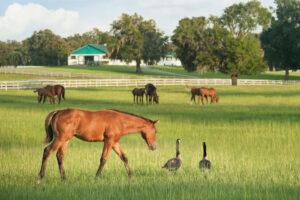California EEE Case Investigation Complete
Final results have been released from a study that investigated the only case of Eastern equine encephalitis (EEE) ever documented in California. The infected Quarter Horse yearling died in the spring of 2000 (See Article Quick Find
- Topics: Article, Eastern Equine Encephalitis (EEE)
Final results have been released from a study that investigated the only case of Eastern equine encephalitis (EEE) ever documented in California. The infected Quarter Horse yearling died in the spring of 2000 (See Article Quick Find #1102 for an archived article). The disease is mostly seen on the East Coast, and is rarely diagnosed west of the Mississippi and Texas. While the source of the infection was not definitively identified, it is possible that an incompletely inactivated vaccine virus infected the horse.
The study was published in a recent issue of the Centers for Disease Control’s online peer-reviewed journal, Emerging Infectious Diseases. The article can be accessed at https://www.cdc.gov/ncidod/EID/vol8no3/01-0199.htm. Research team members were from the Humphrey, Giacopuzzi & Associates Equine Hospital in Somis, Calif.; The University of California-Davis, the California Department of Health Services in Sacramento, the National Veterinary Service laboratory in Ames, Iowa; and the U.S. Army Medical Research Institute of Infectious Diseases in Fort Detrick, Md.
The study states that California’s Arboviral Encephalitis Surveillance Program is among the most comprehensive in the United States. The farm where the EEE case was found participated in the program and had a sentinel chicken flock located adjacent to the farm (sentinel chicken flocks are screened periodically for mosquito-borne diseases to detect any threat of epidemics). Locally infected mosquitoes were apparently not the source of exposure, and there was no evidence of spread from the infected horse to the local mosquito populations based on the screening of area sentinel flocks and mosquito pools.
After excluding the possibilities of natural infection, bioterrorism, and importation, the researchers had to consider incomplete formalin (a clear aqueous solution of formaldehyde containing a small amount of methanol) inactivation of the EEE virus (EEEV) in the vaccine that had been given to the horse prior to disease onset
Create a free account with TheHorse.com to view this content.
TheHorse.com is home to thousands of free articles about horse health care. In order to access some of our exclusive free content, you must be signed into TheHorse.com.
Start your free account today!
Already have an account?
and continue reading.

Related Articles
Stay on top of the most recent Horse Health news with
















